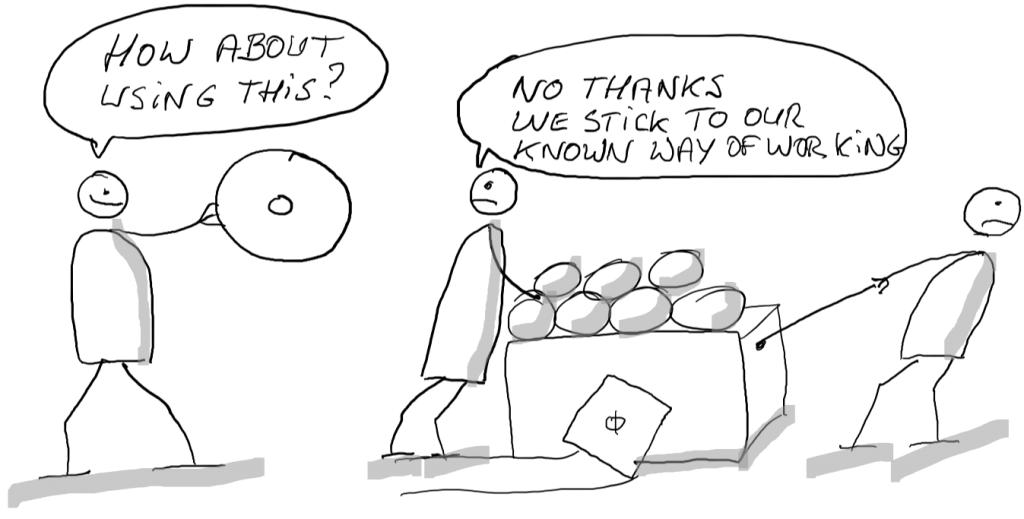An important driver for organizations to become an agile organization is the need to cope with fast changing external circumstances. This can be anything like new technology, new eco-platforms, new legislation, new competitor products etcetera. This implies that innovation is a key element in the strategy. In this article I will focus on three different ways of dealing with innovation for an agile organization. The conclusion is that all three types of dealing with innovation are advised to be used in parallel in order to stay relevant in your own ecosystem.

Understanding the ability to adapt quickly
Nowadays the environment for organizations is often described as ‘living in a VUCA world’. VUCA is the abbreviation for Volatile, Uncertain, Complex and Ambiguous. Originally coming from the military world, it is now often used in society to indicate that no organization can just lay back under the assumption that customers will always buy their products. Over the years we have seen numerous examples of organizations that fail to adapt quickly enough to changing circumstances. Those examples can be found in all industries and public domains as well.
Companies are experimenting with the best way to overcome this. Some were doing that as early as possible (‘Fix the roof when the sun shines.’), some are dealing with that with their backs against the wall. But all organizations came to the conclusion that a vital requirement is to create mechanisms that recognize the relevant topics in the environment. This accounts for product feature kind of topics (e.g. offering Apple Pay in your suite of payment solutions) as well as for the more disruptive kind of topics (Non-banks offering consumer loans or new players offering trade services by using blockchain technology). But recognizing these elements is one thing, the ability to act accordingly is another thing. As Arjen van Berkum describes in his article ‘are innovation departments a thing of the past’, organizations have to choose for an inward out, outward in approach or both. Organizations that still perform product management from an organizational silo perspective are struggling with the long lead times resulting from that. Other organizations have already made the transformation towards an agile organization with an agile way of working. The promise for that was, assuming well implemented, that it would drastically improve the lead time to market and would lower the product risk.
An agile way of working encourages innovation
In agile organisations, multi-disciplined teams are seen as the solution for developing and maintaining the right set of products. The teams should be designed in such a way that their purpose creates as much as possible an end-to-end responsibility. This design of the numerous teams should be inspired by the envisioned customer experience. The disciplines within the team are sufficient to cater for all aspects of the product like product management, IT, User Experience etc. If needed the teams can be temporary extended by experts (see the article ‘agilize the support functions too’). This results in the fact that various aspects are immediately taken into consideration when the team is discussing new product features. It creates the focus on those elements that are really creating value for the customers, delivered in short cycles with active learning moments. This is nowadays seen as a normal practice for agile teams.
Innovation type Horizon-1
In February 2019 McKinsey published an article on the three horizon model for innovation. The kind of innovation described above is called a horizon-1 kind of innovation. This can also exceed the purpose of one team or cluster of teams. The team activities on this kind of innovations are made transparent on the portfolio wall of an Obeya room.
Innovation type Horizon-2
A more difficult type of innovation is called horizon-2. This is often visible at least at the tactical leadership level of an organisation. This type of innovation is often complex regarding design, expected impact and implementation. Consider an organization that intends to use their current product offering in a specific country to a new market segment. This need a lot of product design (Does it fit the customer needs/journey?). Because of this complexity organizations often organize it as a programme or solution in a SAFe environment. This differs from the original waterfall type of running programmes. In the agile delivery world the programme organization is there to define the WHY and WHAT (in terms of business value and business case) and the orchestration. The agile teams however actively participate on the WHAT and do decide on the HOW. They will use all their competences in delivering value to the new initiative as quickly as possible using an iterative and incremental way of working.
Also this horizon-2 activity is made transparent on the portfolio wall of the Obeya rooms. But as this initiative is often performed by different clusters of teams (Tribes/Agile Release Trains – ART), the transparency is also split. At the Obeya on tactical level, for instance at country level in a large global organisation, the overall status is seen while at the individual cluster of teams (tribes/ART’s) their contribution is seen. So the end result of organizing horizon-2 innovations is still that the whole lifecycle of the initiative (from original idea to implementation to maintenance) is part of the existing instruments for that (Aligned Autonomy Process combined with Obeya).
Innovation type Horizon-3
The most complex innovation however is the horizon-3 type. This is innovation that often disrupts the existing business model. Most organizations have difficulties in organizing this from within their own organization. But ignoring the disrupting innovations is not a good strategy. Either your competitor or a complete new kid on the block will disrupt you. A model that is often used is to facilitate and finance a potential disruptor. This may sound strange, but if an organization is creating an eco-platform where also external startups can participate, a win/win situation is created. The win for the start-up is that it will get the funding needed, but more important, that it can experiment and grow in a culture of a small start-up company. Experimenting without too many people looking over your shoulder and without the bureaucratic burden of a large organization. The win for the facilitating organization is that the disruptor becomes a ‘friendly’ disruptor. This means that if the innovation gives promising results in the start-up context, discussions can start in what way the new product or service can become part of the bigger portfolio of products and services of the facilitating organization. If the new product is mature enough, it can either become an integral part of the bigger organization (it is able to survive now in a more bureaucratic structure) or it will be launched as a independently operating but subsidiary of the bigger organization. There are many examples of this for instance in the financial industry, where an insurance company starts an online bank disrupting the existing players.
As these horizon-3 type of innovations are strategic choices, the status of the innovation becomes transparent at the strategic Obeya level. In this way it is connected with all other change and innovation activities in the organization. It also fosters the situation that if a successful disruptive start-up is decided to become part of the mainstream portfolio, the landing area is prepared for that.
Conclusion
As innovation is seen as crucial for most organizations, it is important that all types of innovations are part of the scaled agile processes. This counts for the small as well as the disruptive type of strategic important innovations. It becomes very transparent at all levels which innovations are active. This facilitates all related teams and groups of teams in the organization to optimally anticipate on it and collaborate with it.
